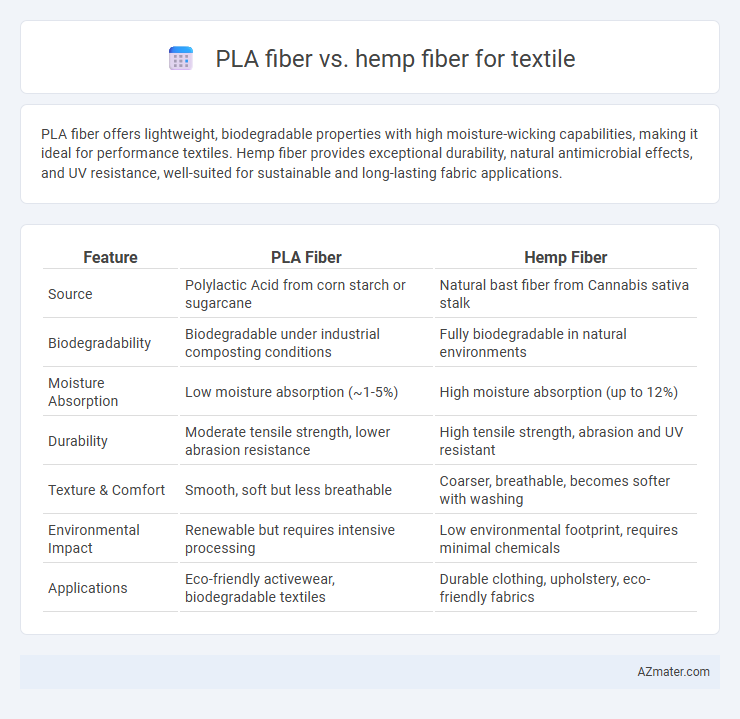PLA fiber offers lightweight, biodegradable properties with high moisture-wicking capabilities, making it ideal for performance textiles. Hemp fiber provides exceptional durability, natural antimicrobial effects, and UV resistance, well-suited for sustainable and long-lasting fabric applications.
Table of Comparison
| Feature | PLA Fiber | Hemp Fiber |
|---|---|---|
| Source | Polylactic Acid from corn starch or sugarcane | Natural bast fiber from Cannabis sativa stalk |
| Biodegradability | Biodegradable under industrial composting conditions | Fully biodegradable in natural environments |
| Moisture Absorption | Low moisture absorption (~1-5%) | High moisture absorption (up to 12%) |
| Durability | Moderate tensile strength, lower abrasion resistance | High tensile strength, abrasion and UV resistant |
| Texture & Comfort | Smooth, soft but less breathable | Coarser, breathable, becomes softer with washing |
| Environmental Impact | Renewable but requires intensive processing | Low environmental footprint, requires minimal chemicals |
| Applications | Eco-friendly activewear, biodegradable textiles | Durable clothing, upholstery, eco-friendly fabrics |
Introduction to PLA and Hemp Fibers
PLA fiber, derived from renewable resources like corn starch, offers biodegradability and a lightweight texture ideal for sustainable textiles. Hemp fiber, obtained from the stalks of the Cannabis sativa plant, is renowned for its strength, durability, and natural resistance to UV and pests, making it a valuable material for eco-friendly fabrics. Both fibers present significant environmental benefits, with PLA providing a synthetic yet compostable alternative, while hemp supports traditional natural fiber applications with enhanced robustness.
Origin and Production Processes
PLA fiber is derived from renewable resources like corn starch or sugarcane through a fermentation process followed by polymerization, creating polylactic acid suitable for textile applications. Hemp fiber originates from the stalks of the Cannabis sativa plant and undergoes mechanical retting, decortication, and scutching to separate and refine strong bast fibers ideal for durable fabrics. Production of PLA fiber involves biotechnological methods producing biodegradable synthetic fibers, whereas hemp fiber production relies on traditional agricultural and processing techniques emphasizing natural fiber extraction.
Environmental Impact Comparison
PLA fiber, derived from renewable resources like corn starch, offers biodegradability and lower greenhouse gas emissions during production compared to conventional synthetic fibers. Hemp fiber excels in environmental sustainability due to its minimal water requirements, natural pest resistance, and ability to improve soil health through phytoremediation, resulting in a significantly lower ecological footprint. While both fibers present eco-friendly alternatives, hemp's natural cultivation advantages and carbon sequestration capabilities position it as a superior choice for reducing overall environmental impact in textile manufacturing.
Biodegradability and End-of-Life
PLA fiber demonstrates hydrolytic biodegradability under industrial composting conditions, breaking down into lactic acid within months, while hemp fiber offers rapid natural biodegradability in soil environments due to its cellulose and lignin structure. Both fibers provide eco-friendly end-of-life options, with hemp decomposing more readily in diverse environments and PLA requiring controlled composting facilities to achieve complete degradation. Selection between PLA and hemp depends on local waste management infrastructure and desired environmental impact, with hemp favored for natural soil integration and PLA suited for circular industrial composting systems.
Fiber Properties and Performance
PLA fiber, derived from renewable corn starch, exhibits high tensile strength and excellent moisture-wicking properties, making it suitable for lightweight and breathable textiles. Hemp fiber, known for its durability and antimicrobial qualities, offers superior UV resistance and natural mold protection, contributing to long-lasting fabric performance. Both fibers provide sustainable alternatives, with PLA excelling in biodegradability and hemp offering enhanced strength and thermal regulation for diverse textile applications.
Applications in the Textile Industry
PLA fiber, derived from renewable resources like corn starch, offers excellent moisture-wicking and biodegradability properties, making it suitable for activewear, footwear linings, and disposable medical textiles in the textile industry. Hemp fiber, known for its durability, natural antimicrobial qualities, and UV resistance, is widely used in eco-friendly fashion, upholstery, and home textiles requiring high strength and longevity. Both fibers contribute to sustainable textile production but cater to different performance needs, with PLA favored for lightweight, breathable fabrics and hemp valued for robust, long-lasting materials.
Cost and Market Availability
PLA fiber, derived from renewable resources like corn starch, generally has higher production costs compared to hemp fiber due to its complex manufacturing process and reliance on bioplastic technology. Hemp fiber benefits from well-established agricultural practices and lower processing expenses, making it more cost-effective and readily available in global textile markets. Market availability of PLA fiber remains limited and niche, while hemp fiber enjoys broader access and consistent supply due to its long-standing use in sustainable textiles.
Consumer Perception and Safety
PLA fiber, derived from renewable resources like corn starch, is favored by consumers for its eco-friendly and biodegradable properties, making it a popular choice in sustainable textiles. Hemp fiber, known for its durability and natural antimicrobial qualities, appeals to customers seeking organic and hypoallergenic fabric options with minimal chemical treatments. Both fibers are recognized for their safety, with PLA offering allergen-free use and hemp providing resistance to mold and UV exposure, enhancing overall consumer confidence in their textile applications.
Sustainability Certifications and Standards
PLA fiber, derived from renewable corn starch, holds certifications like OEKO-TEX Standard 100 and Global Recycled Standard, ensuring its sustainability and non-toxicity in textiles. Hemp fiber, recognized by certifications such as GOTS (Global Organic Textile Standard) and USDA Organic, is praised for its minimal pesticide use and biodegradability, making it a strong eco-friendly option. Both fibers meet rigorous sustainability standards, but hemp's organic certification highlights its superior environmental benefits in textile production.
Future Trends in Eco-Friendly Textiles
PLA fiber, derived from renewable resources such as corn starch, offers excellent biodegradability and moisture-wicking properties, making it a promising material for sustainable textiles. Hemp fiber stands out for its strength, durability, and low environmental impact due to minimal pesticide use and rapid growth cycles. Future trends indicate increased integration of both PLA and hemp fibers in eco-friendly textile manufacturing to meet growing consumer demand for biodegradable, renewable, and sustainable fabrics.

Infographic: PLA fiber vs Hemp fiber for Textile
 azmater.com
azmater.com